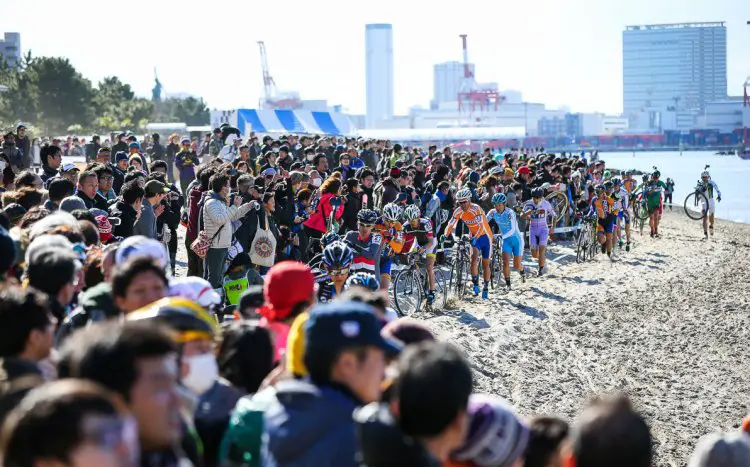After publishing the 2017-2018 UCI Cyclocross Race calendar yesterday and noticing eight U.S. events from last season have dropped off the calendar, we were curious as to how the landscape of UCI races has changed and whether there were any noticeable trends.
First, some corrections. We said based on our “rough count” that there were two dozen more race days. That was pretty far off, due to a flawed comparison to an early but outdated 2016-2017 race calendar that did not include a lot of the UCI-sanctioned National Championships abroad. There’s really only three additional UCI race days based on our updated “rough” count, thanks to spreadsheets. We also said there was a net change of four less U.S. race days, but that was off by two. The 2016-2017 calendar did not include the late addition of the KMC Cross Fest.
A Small U.S. Contraction
After making those corrections, our latest tally is six fewer UCI racing days in the U.S., but the States still leads the way in number of UCI races.
One could argue that less UCI events could be a good thing. Anyone old enough to remember the Saturn SuperCup and USGP series might have fond memories of a time when the country’s top talent all converged in one area to battle and put on a show.

Remembering the days of one national UCI series. photo: Jonny “The Cat” Sundt. Seen here as he hops the barriers at the Saturn Super Cup on his Redline Conquest. © Cyclocross Magazine
Of course, the fluctuation of UCI events is not necessarily a sign of anything more than the number of motivated promoters looking to raise the stature of an event and offer racers a chance to bump up their rankings—and the financial possibilities of doing so again.
In the U.S., UCI races vary greatly in terms of participation, fans and prize money (especially when it comes to women). The vast majority of the UCI races stay east of the Mississippi, in denser populated areas, leveraging a network effect that makes travel more economical.
Promoters in other areas like Texas, California, Washington and Oregon have bumped up events to UCI status in the past, hoping to partially equalize the East-leaning calendar, but as we’ve seen with Texas’ four late-season days that have gone missing, the efforts are often short-lived.

After a week of Nationals in 2015 and four UCI events on the UCI calendar in 2016, Texas will suffer a UCI points drought this season. photo: Gage Hecht is used to riding at the front from the 2015 Cyclocross National Championships, and led the entire field on lap one in Hoogergheide. © Cyclocross Magazine
Those four missing Texas days, combined with Ohio’s North Coast UCI weekend and Nittany Lion moving away from UCI status (Nittany shares the Jingle Cross weekend) makes for eight UCI days going away, partially offset by the West Sacramento Cyclocross Grand Prix’s bump up to two days of C2 racing.
Short-Lived Experiments?
The contraction isn’t limited to the States. Last season we saw UCI-sanctioned Nationals in Chile, Hungary, Israel, Sweden, Slovakia and Finland, and those events are not on this year’s current calendar. Without talking to the promoters and governing bodies (yet), we can’t speculate as to why the brief stay in UCI land, but it was neat to see the (short-lived) expansion.

Hungarian Zsolt Búr started 71st at 2017 World Championships, and worked his way up to 50th. © Cyclocross Magazine
Perhaps the events will return, as the UCI has a history of being relaxed with deadlines when it comes to expansion beyond traditional cyclocross countries, and we saw last year, such events can be late-season additions.
Hungarian Zsolt Bur is certainly doing his part to raise the level of cyclocross in Hungary.
A Rising Sun
So where are the new events appearing?
In Japan.

UCI points or not, Japan’s races attract the masses and keep growing. photo: Some estimated the crowds to be 20,000 strong. 2017 CX Tokyo. © Kei Tsuji
The growth out in the Far East should be no surprise if you’ve been following our (sporadic) coverage of Japanese cyclocross over the years. Whether it’s the impressive, structured, anti-sandbagging grassroots scene in Saitama, picturesque UCI racing in the Japanese Alps in Nobeyama, the Slip ‘N Slide mudfest in Chiba or the crowd-pleasing beach racing in Tokyo, Japan’s cyclocross racing has been healthy and growing.
While UCI racers hailing from Japan are nothing new (there was an era when the country typically out-placed Americans at Worlds), the growth in participation has been impressive this decade. Japan gains three new C2 events, plus an extra day of UCI racing at Nationals. For such a densely-populated country, cyclocross might be the perfect sport for participants and spectators.
For the 2017-2018 season, Japan gains three new C2 events, plus an extra day of UCI racing at Nationals. For such a densely-populated country, cyclocross might be the perfect sport for participants and spectators.
American Points Migrate North, South
While Japan’s growing slice of the UCI points pie partially offsets an American contraction, Australia and Canada welcome the American migration with open arms, as both countries pick up two new days of UCI racing with the Australian Fields of Joy CX weekend and Canadian Silver Goose weekend in Ontario, respectively.

Canada adds UCI racing beyond Nationals for 2017. photo: Raphael Gagne wins the 2015 Shimano Canadian Cyclocross Championships © Randy Lewis/lewisimages
Over in Europe, changes appear relatively small, with France boasting the biggest changes, adding both a C1 and C2, a World Cup and an extra day of Nationals, while losing the Continental Championships.
Overall, the points and racing are still largely concentrated in the same areas. Still, it’s still fun for us geeks to crunch the numbers and look to see what’s changed.
Have a look for yourself in the two tables below. A guide to the abbreviations sits below both tables.
2017-2018 UCI Cyclocross Race Count by Country and Classification
| Nat | C1 | C2 | CC | CCM | CDM | CM | CMM | CN | Total |
|---|---|---|---|---|---|---|---|---|---|
| USA | 7 | 31 | 1 | 0 | 2 | 0 | 0 | 1 | 42 |
| BEL | 18 | 13 | 0 | 0 | 3 | 0 | 2 | 2 | 38 |
| SUI | 6 | 5 | 0 | 0 | 0 | 0 | 0 | 2 | 13 |
| CZE | 3 | 4 | 1 | 1 | 0 | 0 | 0 | 2 | 11 |
| ESP | 0 | 9 | 0 | 0 | 0 | 0 | 0 | 2 | 11 |
| NED | 2 | 4 | 0 | 0 | 1 | 2 | 0 | 2 | 11 |
| FRA | 4 | 3 | 0 | 0 | 1 | 0 | 0 | 2 | 10 |
| JPN | 0 | 7 | 0 | 0 | 0 | 0 | 0 | 2 | 9 |
| GBR | 1 | 5 | 0 | 0 | 0 | 0 | 0 | 2 | 8 |
| ITA | 0 | 5 | 0 | 0 | 0 | 0 | 0 | 2 | 7 |
| DEN | 0 | 1 | 0 | 0 | 1 | 0 | 0 | 2 | 4 |
| LUX | 0 | 3 | 0 | 0 | 0 | 0 | 0 | 1 | 4 |
| AUS | 0 | 2 | 0 | 0 | 0 | 0 | 0 | 1 | 3 |
| CAN | 0 | 2 | 0 | 0 | 0 | 0 | 0 | 1 | 3 |
| GER | 0 | 0 | 0 | 0 | 1 | 0 | 0 | 2 | 3 |
| AUT | 0 | 2 | 0 | 0 | 0 | 0 | 0 | 0 | 2 |
| CHN | 2 | 0 | 0 | 0 | 0 | 0 | 0 | 0 | 2 |
| POL | 0 | 0 | 0 | 0 | 0 | 0 | 0 | 2 | 2 |
| POR | 0 | 1 | 0 | 0 | 0 | 0 | 0 | 1 | 2 |
| EST | 0 | 0 | 0 | 0 | 0 | 0 | 0 | 1 | 1 |
| IRL | 0 | 0 | 0 | 0 | 0 | 0 | 0 | 1 | 1 |
| NOR | 0 | 0 | 0 | 0 | 0 | 0 | 0 | 1 | 1 |
| SVK | 0 | 1 | 0 | 0 | 0 | 0 | 0 | 0 | 1 |
| SWE | 0 | 1 | 0 | 0 | 0 | 0 | 0 | 0 | 1 |
| CHI | 0 | 0 | 0 | 0 | 0 | 0 | 0 | 0 | 0 |
| FIN | 0 | 0 | 0 | 0 | 0 | 0 | 0 | 0 | 0 |
| ISL | 0 | 0 | 0 | 0 | 0 | 0 | 0 | 0 | 0 |
2017-2018 UCI Cyclocross Races - Net Changes by Country, Classification
| Nat | C1 | C2 | CC | CCM | CDM | CM | CMM | CN | Total |
|---|---|---|---|---|---|---|---|---|---|
| USA | -2 | -4 | 0 | 0 | 0 | 0 | 0 | 0 | -6 |
| SWE | 0 | -1 | 0 | 0 | 0 | 0 | 0 | -1 | -2 |
| ITA | 0 | -1 | 0 | 0 | -1 | 0 | 0 | 1 | -1 |
| LUX | 0 | 0 | 0 | 0 | 0 | -1 | 0 | 0 | -1 |
| NOR | 0 | 0 | 0 | 0 | 0 | 0 | 0 | -1 | -1 |
| CHI | 0 | 0 | 0 | 0 | 0 | 0 | 0 | -1 | -1 |
| FIN | 0 | 0 | 0 | 0 | 0 | 0 | 0 | -1 | -1 |
| ISL | 0 | 0 | 0 | 0 | 0 | 0 | 0 | -1 | -1 |
| HUN | 0 | 0 | 0 | 0 | 0 | 0 | 0 | -1 | -1 |
| AUT | 0 | 1 | 0 | 0 | 0 | 0 | 0 | -1 | 0 |
| CHN | 0 | 0 | 0 | 0 | 0 | 0 | 0 | 0 | 0 |
| ESP | 0 | -1 | 0 | 0 | 0 | 0 | 0 | 1 | 0 |
| EST | 0 | 0 | 0 | 0 | 0 | 0 | 0 | 0 | 0 |
| GER | 0 | -1 | 0 | 0 | 0 | 0 | 0 | 1 | 0 |
| IRL | 0 | 0 | 0 | 0 | 0 | 0 | 0 | 0 | 0 |
| POL | 0 | 0 | 0 | 0 | 0 | 0 | 0 | 0 | 0 |
| SUI | 0 | -1 | 0 | 0 | 0 | 0 | 0 | 1 | 0 |
| SVK | 0 | 1 | 0 | 0 | 0 | 0 | 0 | -1 | 0 |
| BEL | -1 | 0 | 0 | 0 | 0 | 0 | 1 | 1 | 1 |
| DEN | 0 | -1 | 0 | 0 | 1 | 0 | 0 | 1 | 1 |
| GBR | 1 | -1 | 0 | 0 | 0 | 0 | 0 | 1 | 1 |
| NED | 0 | 0 | 0 | 0 | -1 | 2 | 0 | 0 | 1 |
| POR | 0 | 1 | 0 | 0 | 0 | 0 | 0 | 0 | 1 |
| AUS | 0 | 2 | 0 | 0 | 0 | 0 | 0 | 0 | 2 |
| CAN | 0 | 2 | 0 | 0 | 0 | 0 | 0 | 0 | 2 |
| CZE | 0 | 0 | 1 | 1 | 0 | 0 | 0 | 0 | 2 |
| FRA | 1 | 1 | -1 | 0 | 1 | 0 | 0 | 1 | 3 |
| JPN | 0 | 3 | 0 | 0 | 0 | 0 | 0 | 1 | 4 |
What do the classes mean?
- CDM=World Cup
- CM=World Championships
- CC=Continental Championships
- CCM=Masters Continental Championships
- CMM=Masters World Championships
- CN=National Championships
- C1=UCI C1 status, with points going 15 places deep, 80 points to the winner
- C2=UCI C2 status, with points going 10 places deep, 40 points to the winner




























